
I’ll admit right from the get-go that I’m probably a bit biased when it comes to Michael Jan Krizik’s Reverie. If you take a look in the readme, you might see why: I did a little playtesting for this WAD back in the day, when the pieces were still coming together. I’m not sure my feedback was all that helpful, but just being able to play a WAD before it’s released publicly has a way of endearing you to the final product more than you might have been otherwise.
That’s not to say Reverie is bad and I’m giving it a free pass. It also doesn’t mean I’m blindly in love with the thing. I can still look at it with something sort of resembling objectivity. And I will. It’s a flawed masterpiece, with emphasis on the “flawed.” It’s also undeniably awesome.
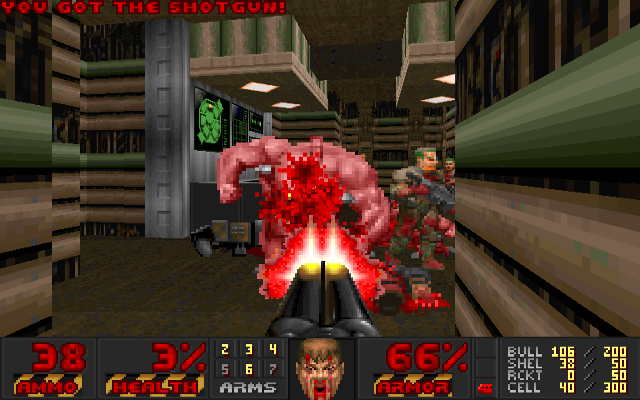
If you look up “mixed bag” on Wikipedia, the featured image should be a screenshot from Reverie. Coming back for another playthrough after a few years have passed I still had trouble deciding how I felt about this WAD. When it’s on, boy howdy is it on. But when it’s off, man — it can be pretty rough. Even my staunch anti-cheating policy was a casualty of the mixed feelings I had on this one. This is one of the few WADs where I’d honestly not be offended at all if you skipped around between levels. I’d probably recommend it, actually.
Here’s the thing: there’s too much brilliance packed into Reverie to risk getting hung up on one of the low points and quitting out of frustration. If you spend a while not having fun, don’t be afraid to skip to the next level. I even did it myself… just please don’t revoke my WAD reviewing license.
Okay — at this point you’re wondering what could make for such a schizophrenic experience. Let’s start with the bad stuff so I can get that out of the way and move on to the fun part.
“Bad stuff” might be slightly misleading. There’s really only one problem with the whole mapset — but it is a doozy, and it is present in a lot of levels. I will sum it up in the following sentence: “Where the heck do I go?”
If I had to point at a specific level as the worst offender, it would be Map10. Map04 suffers from some of the same issues, though, and it’s the one you’ll encounter first. It’s also the point at which two of Reverie’s defining traits enter stage left.
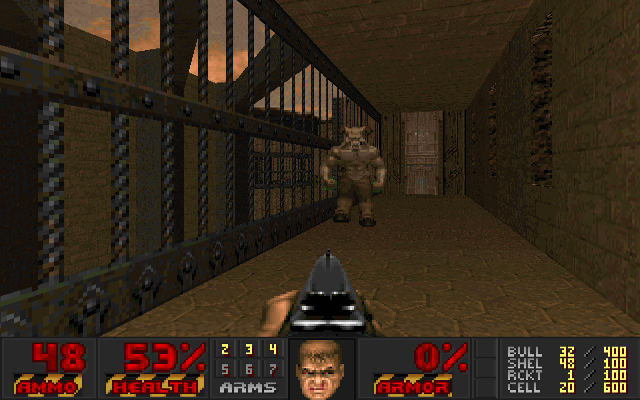
1. Jan Krizik has no qualms about crushing his players, utterly and without warning. After three levels of relative ease even on Ultra-Violence, the fourth map is what you might at first pass off as a temporary difficulty spike. It’s not. The rest will be this hard or much harder. Not that I’m complaining; it’s nice to play a WAD where I’m actually punished for mindlessly choosing the hardest difficulty at startup.
2. A lot of Reverie’s maps suffer from a severe lack of direction for the player. This is only the first of many.
Like 04 here, they tend to start off strong and pretty straightforward. Reverie is fond of its switch-hunts, though, which ultimately are the downfall of a lot of these levels. As long as the explorable area stays small it’s easy to figure out what the switches you’re hitting are doing, but as newer and larger parts of the level become accessible, things get confusing fast. Many of them end up in these long daisy-chained switch-door-switch-door sequences. Jan Krizik is usually pretty good about putting the switch at least semi-near the thing it activates, or about hinting at what it does, but if you ever lose the trail of breadcrumbs — it’s over, man. You probably won’t even remember which switch you hit last.
With that pseudo-disclaimer out of the way, let’s board the train to someplace more positive…
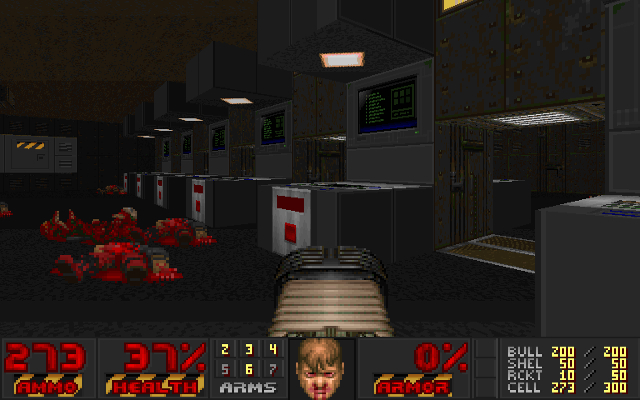
Okay, so… I love this WAD. I know I said earlier that I had mixed feelings, but I’ve made my final decision. It’s pure, unadulterated classic Dooming, and I can’t help but love it. Even at times when the WAD is making some of its worse design sins, it does it without shame. Reverie feels less like it’s plagued by real mistakes and more like it’s paying tribute to the classics of the ’90s — to WADs and WAD creators who held passion and playfulness above presentation and polish.
That’s where Reverie comes through. It has the air of wild abandon that we seem to have lost a lot of as a community. At the same time it’s making you feel at home with callbacks to original Doom II levels, it’s experimenting with all sorts of lost ’90s Doom tropes.
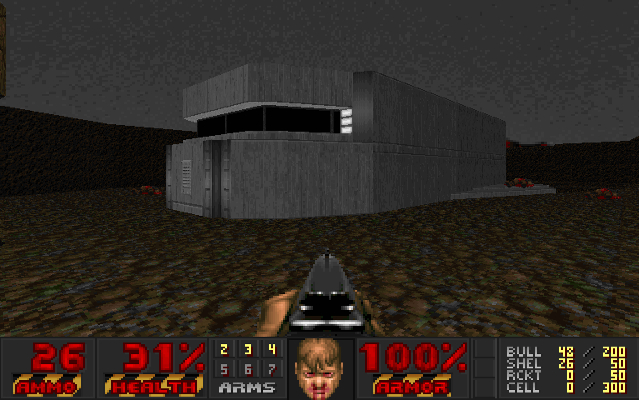
And of course, with the experimentation comes some genuine freshness. One of my favorite moments is the impossibly hard Map18, Sleeping Spirits, which makes clever use of a bug in the original Doom engine to create nigh-unkillable ghost imps who stalk you for the whole level, passing directly through doors, walls, whatever you try to put between you and them. Never before have I felt such a real sense of panic playing Doom.
All the fun design and focus on the bigger picture rather than making individual areas pretty, unfortunately — well, it makes it hard to show you how awesome Reverie is just through still images. Take this, for example:
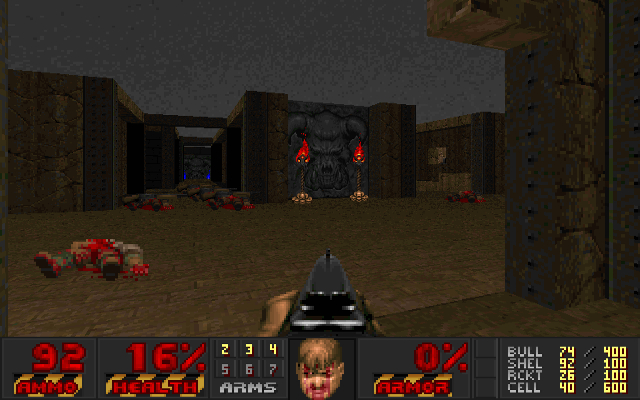
This screenshot is from my favorite map of the bunch. Map13, Stronghold Earth, is a gorgeous Hell-fortress-on-a-ruined-Earth type map, with a large but easily understood layout. The gameplay is intense and each battle different from the last, the switch-hunting is kept to a minimum, and the aesthetic — while keeping details at a level vanilla Doom can handle — is nothing short of beautiful. It’s a concept that’s not particularly novel, but it’s executed so masterfully that this map has stuck with me since I first played Reverie years ago. Still, even if the shot above is of one of the nicer looking areas, I doubt it’s doing much for you. Like a lot of Doom maps, you’ve got to play it yourself.
Salvation too, the penultimate level, is one of the most satisfying you’re-almost-at-the-end!, pump-you-up-for-the-final-challenge maps I’ve played. As weird as it is to say, considering the number of enemies Jan Krizik dumps on you here, Salvation has an elegant restraint to it — something the rest of the WAD could have benefited from. The reality is that it’s a fairly traditional arena-style map, but you can’t argue with the results.
What completely sells me is the setting. Something about battling cyberdemons on a platform floating in a grey and pink sunset just pushes the right buttons for me.
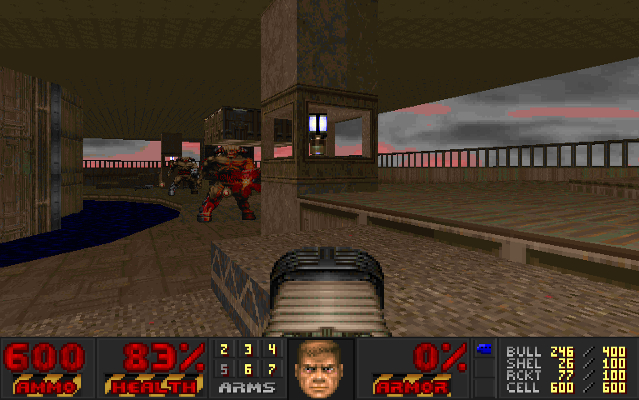
I certainly wouldn’t want every level to be a small arena like this, of course, but I do think maps like Salvation and Stronghold Earth benefit immensely from a more focused design. They draw their strength from a single idea, and use that idea to its fullest. Even more, they don’t overwhelm the player with a seemingly endless series of switches. I hate to harp on that, but even if it does conjure up cheerful memories of playing old megaWADs — or playing Hexen, even — I can’t help feeling like there were better ways to do that.
I’m a little ashamed I had to skip around the WAD, and I wish I didn’t. Had I not, though, I may have given up somewhere around Map10. Having experienced the brilliant levels, especially in the latter half, I’m glad I did cheat my way to those. In any case, it’s worth checking out. Heck, the maps I didn’t like may be some of your favorites.
Reverie requires DOOM2.WAD and should run in vanilla Doom or any source port under the sun. If you’re not sure how to get it running, this may help. And for more awesome WADs, be sure to check these out!